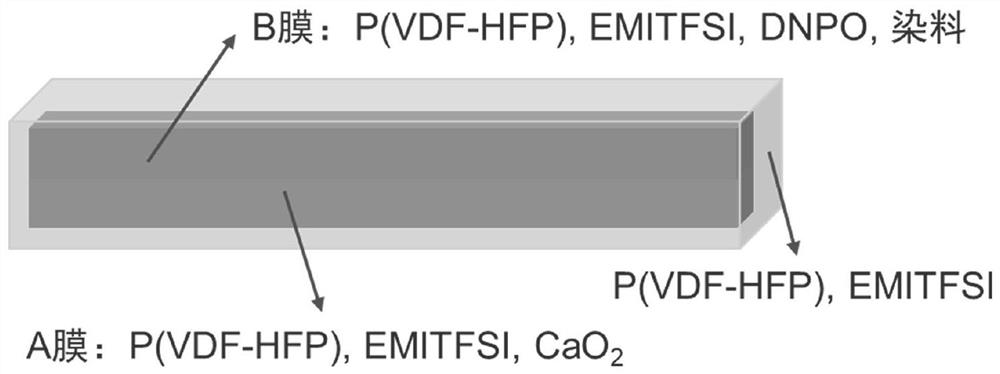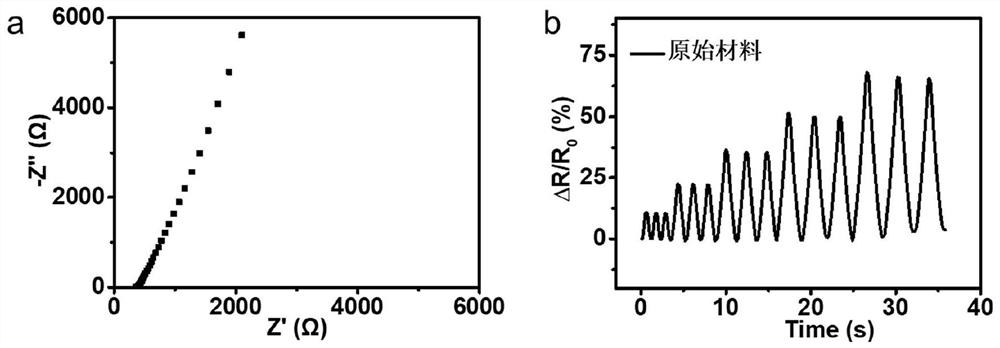Underwater damage self-alarming and self-repairing material as well as preparation method and application thereof
A self-healing material and water-reactive technology, applied in the field of polymers, can solve problems such as impracticability and damage self-alarm, and achieve excellent electrical conductivity and excellent sensing performance
- Summary
- Abstract
- Description
- Claims
- Application Information
AI Technical Summary
Problems solved by technology
Method used
Image
Examples
preparation example Construction
[0045] In a second aspect, the present invention provides a method for preparing the self-alarming and self-repairing material for underwater damage, comprising the following steps:
[0046] A layer is prepared by mixing a substance that can react with water to generate hydrogen peroxide, a fluorine-containing polymer, an ionic liquid and an organic solvent;
[0047] Mixing peroxyoxalate, dye, fluorine-containing polymer, ionic liquid and organic solvent uniformly, drying after rotary evaporation, and hot pressing to form a film to prepare layer B;
[0048] Superimpose layer A and layer B;
[0049] The material prepared by mixing and coupling the fluoropolymer and the ionic liquid wraps the superimposed layer of the A layer and the B layer to form a hydrophobic protective layer.
[0050] In a third aspect, the present invention provides that the underwater damage self-alarming and self-healing material has potential applications in the fields of ionic skin and strain sensor p...
Embodiment 1
[0067] Preparation method of film A: Dissolve P(VDF-HFP) (10g) and EMITFSI (8g) in acetone at room temperature to obtain a homogeneous solution and then add CaO 2 (2g). Rotary steaming, drying, and compression molding to obtain A film.
[0068] Preparation method of B film: P(VDF-HFP) (10g) and EMITFSI (8g) were dissolved in acetone at room temperature to obtain a homogeneous solution, and then DNPO (2g) and DPA (0.003g) were added. Rotary steaming, drying, and compression molding to obtain B film.
[0069] Preparation method of hydrophobic transparent film: P(VDF-HFP) (10 g) and EMITFSI (8 g) were dissolved in acetone at room temperature to obtain a homogeneous solution. Then, rotary steam, drying, and compression molding are performed to obtain a hydrophobic transparent film.
[0070] The A film and the B film are first assembled into a whole, and then tightly wrapped with a hydrophobic transparent film to obtain the final material, whose structure is as follows: figure ...
Embodiment 2
[0074] Preparation method of film A: Dissolve P(VDF-HFP) (10g) and EMITFSI (5g) in acetone at room temperature to obtain a homogeneous solution and then add CaO 2 (2g). Rotary steaming, drying, and compression molding to obtain A film.
[0075] Preparation method of film B: P(VDF-HFP) (10g) and EMITFSI (5g) were dissolved in acetone at room temperature to obtain a homogeneous solution, and then DNPO (3g) and BPEA (0.001g) were added. Rotary steaming, drying, and compression molding to obtain B film.
[0076] Preparation method of hydrophobic transparent film: P(VDF-HFP) (10 g) and EMITFSI (5 g) were dissolved in acetone at room temperature to obtain a homogeneous solution. Then, rotary steam, drying, and compression molding are performed to obtain a hydrophobic transparent film.
[0077] The A film and the B film are first assembled into a whole, and then tightly wrapped with a hydrophobic transparent film to obtain the final material.
PUM
 Login to View More
Login to View More Abstract
Description
Claims
Application Information
 Login to View More
Login to View More - R&D
- Intellectual Property
- Life Sciences
- Materials
- Tech Scout
- Unparalleled Data Quality
- Higher Quality Content
- 60% Fewer Hallucinations
Browse by: Latest US Patents, China's latest patents, Technical Efficacy Thesaurus, Application Domain, Technology Topic, Popular Technical Reports.
© 2025 PatSnap. All rights reserved.Legal|Privacy policy|Modern Slavery Act Transparency Statement|Sitemap|About US| Contact US: help@patsnap.com



